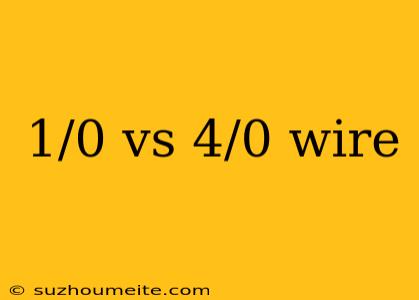Understanding the Difference: 1/0 vs 4/0 Wire
When it comes to electrical wiring, choosing the right gauge wire is crucial for ensuring safe and efficient power transmission. Two common wire gauges used in various applications are 1/0 and 4/0. While they may seem similar, these wires have distinct differences that set them apart. In this article, we'll delve into the characteristics of 1/0 vs 4/0 wire, exploring their uses, advantages, and limitations.
What is Wire Gauge?
Before diving into the specifics of 1/0 and 4/0 wire, let's briefly discuss what wire gauge is. Wire gauge refers to the measurement of a wire's diameter. The American Wire Gauge (AWG) system is commonly used to classify wires based on their diameter. A smaller gauge number indicates a larger diameter, while a larger gauge number indicates a smaller diameter.
1/0 Wire
Definition: 1/0 wire, also known as "one ought" wire, has a diameter of approximately 0.30 inches (7.62 mm) and an AWG rating of 1/0.
Applications: 1/0 wire is commonly used in:
- Residential electrical systems: 1/0 wire is suitable for carrying heavy electrical loads in residential areas, such as in main electrical panels and subpanels.
- Commercial buildings: It's used in commercial buildings for distributing power to electrical equipment and machinery.
- Industrial settings: 1/0 wire is employed in industrial settings for powering heavy machinery and equipment.
Advantages:
- High current-carrying capacity: 1/0 wire has a high current-carrying capacity, making it suitable for heavy-duty applications.
- Low voltage drop: The larger diameter of 1/0 wire reduces voltage drop, ensuring efficient power transmission.
4/0 Wire
Definition: 4/0 wire, also known as "four ought" wire, has a diameter of approximately 0.46 inches (11.68 mm) and an AWG rating of 4/0.
Applications: 4/0 wire is commonly used in:
- High-voltage transmission lines: 4/0 wire is used in high-voltage transmission lines for transmitting power over long distances.
- Industrial power distribution: It's employed in industrial settings for powering heavy machinery and equipment that require high currents.
- Electric vehicle charging stations: 4/0 wire is used in electric vehicle charging stations to support fast charging.
Advantages:
- Higher current-carrying capacity: 4/0 wire has an even higher current-carrying capacity than 1/0 wire, making it suitable for extremely heavy-duty applications.
- Better heat dissipation: The larger diameter of 4/0 wire allows for better heat dissipation, reducing the risk of overheating.
Key Differences
- Diameter: 4/0 wire has a larger diameter than 1/0 wire.
- Current-carrying capacity: 4/0 wire has a higher current-carrying capacity than 1/0 wire.
- Applications: While both wires are used in heavy-duty applications, 4/0 wire is more commonly used in high-voltage transmission lines and electric vehicle charging stations.
Conclusion
In conclusion, both 1/0 and 4/0 wire are used in heavy-duty electrical applications, but they have distinct differences in terms of diameter, current-carrying capacity, and applications. Understanding these differences is crucial for selecting the right wire for your specific needs, ensuring safe and efficient power transmission.
